Downloads
Introduction
Thank you for inviting me to speak today.
It is a pleasure to be here to continue the long conversation between Treasury and the ABE on the macroeconomic outlook.
I shall organise my remarks into two parts.
First, I am going to talk about current economic conditions, focusing on a number of transitions in the international and domestic economies, and how these transitions are shaping our near-term growth outlook.
Then I am going to shift the focus from the near-term to the medium-term economic outlook.
While even more challenging than forecasting over the near term, medium-term economic projections are essential for fiscal agencies such as the Treasury, because they underpin the setting of fiscal policy in a medium-term framework.
Australia’s economic performance in the global context
Australia’s economy has performed remarkably well over the past two decades.
While global shocks brought recession and staggering unemployment to other advanced economies, in Australia output has continued to expand, albeit at a slower rate more recently.
Our unemployment rate has risen to an unacceptably high level in recent years, but it pales beside jobless rates witnessed in other advanced economies as a result of the global financial crisis, as well as in Australia during the recessions in the 1980s and 1990s. And recently we have seen the employed share of the population increase even as activity has failed to accelerate.
But the business cycle is not dead in this country. This is a point that sometimes gets lost in the Australian economic debate, which is perhaps forgivable given that our last genuine recession was now more than 20 years ago.
Without doubt, past micro- and macro-economic reforms have helped to blunt the business cycle’s peaks and troughs. But like other economies, Australia is still subject to disturbances, from both domestic and external sources.
Today, economic events beyond our shores are heavily influencing our economy. The world economy is still dealing with the aftermath of the most severe financial crisis since the 1930s and countries across the world are still struggling to return their economies to pre-crisis growth trajectories.
In Europe, the sense of crisis sparked most recently by Greece has again receded, and a recovery – albeit subdued – remains underway. The euro area unemployment rate has fallen to 10.8 per cent in September from just above 12 per cent in early 2013. This is positive. But the continent continues to face challenges and serious risks still cloud the outlook for euro area growth.
Our economy is now linked to China’s economy more than any other.
This reflects the growing trade ties with China over the past decade, which have seen China’s share of our merchandise exports move from just 5 per cent in 2000 to about one-third now.
Over the past decade, China’s growing demand for commodities provided a huge boost to Australian incomes, and helped Australia avoid a recession during the global financial crisis.
But this economic dependence cuts both ways and we are now feeling the effects of slowing growth in our largest trading partner.
While we always knew that growth would slow in China, the deceleration has been particularly sharp in China’s commodity-hungry industrial sector with this slowdown weighing heavily on global commodity markets over the past year.
The chart shows the sectoral composition of Chinese growth over the past 20 years. Growth in industrial production is now the lowest it’s been in at least two decades.
Combined with large increases in low-cost global commodity supply, the prices of raw materials such as oil, iron ore and coal have more than halved from a year or two ago and are currently trading at prices not seen in around a decade.
Chart 1: Chinese GDP growth by sector
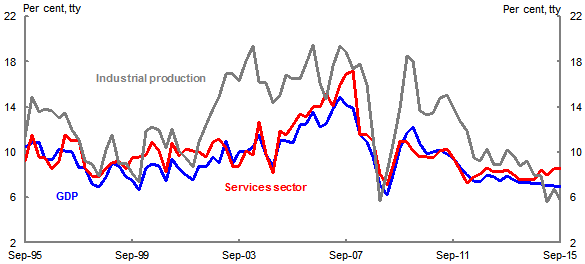
Source: CEIC China Database.
In Japan, our second largest trading partner, the world’s biggest program of quantitative easing has failed to lift inflation expectations or spur economic activity as much as was hoped. Remarkably, Japan’s nominal economy remains around the size it was fifteen years ago.
There is of course still cause for some optimism.
India looks to be on track to record another year of impressive growth in 2015.
The United States economy is now looking much stronger, having almost fully recovered from its worst recession since the Second World War. The unemployment rate has halved to 5 per cent, and the world’s largest economy is again growing robustly.
This is good news for the world as a whole. In previous decades, what was happening in the US economy was a very good predictor of economic conditions in other advanced economies including Australia.
Today, the US and Australian economic cycles are not as tightly linked. This can be seen in our differing labour market experiences of late. In this chart, periods in which our unemployment rates have been trending in opposite directions are marked grey. You can see that our unemployment rates have been trending in opposite directions over most of the past three years - the longest sustained divergence for decades.
Chart 2: Unemployment rate
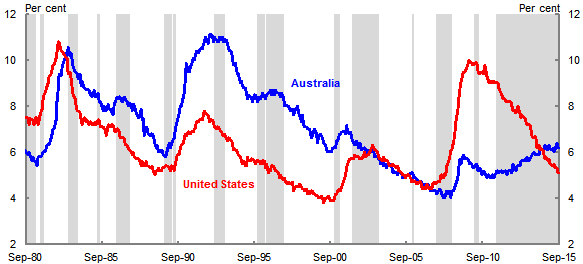
Source: ABS Cat. No. 6202.0 and United States Bureau of Labor Statistics.
Domestic economic conditions and outlook
With the prices of Australia’s key commodity exports falling sharply, growth in nominal GDP fell to just 1½ per cent in 2014-15 – the slowest growth in over fifty years.
In the mid-2000s, the largest terms of trade boom in our history brought record levels of business investment. Employment and incomes grew solidly in mining-related sectors and in the broader economy as well.
We knew that the investment phase of the mining boom would eventually turn from a driver to a drag on growth.
And we knew that the ‘down’ side of the commodity boom would be challenging. But the adjustment to commodity prices occurred somewhat earlier and more sharply than we expected, as weakening Chinese demand coincided with new supply.
We are now four years on from the peak in the terms of trade, and while the ramp-up in mining export volumes is supporting output growth, other sources of domestic demand are not entirely filling the hole left by the steep falls in mining investment.
In fact, the latest national accounts showed that the economy recorded its third straight year of below trend growth in 2014-15.
This means Australia is now in a prolonged period of below-par growth, the likes of which we have rarely seen outside of a recession.
Notwithstanding solid employment gains in October, the unemployment rate remains higher than our estimate of the non-accelerating inflation rate of unemployment (NAIRU).
And broader labour market measures still point to significant spare capacity in the labour market.
The underutilisation rate has risen four percentage points since the financial crisis (to 14 per cent). The hours-to-population ratio has fallen to levels not seen for 25 years. And certain groups in the population have been disproportionally affected, with underutilisation among youth cohorts rising substantially from past levels.
Chart 3: Total underutilisation rate

Source: ABS Cat. No. 6202.0.
Note: Youth is defined as persons aged 15 to 24.
Chart 4: Youth underutilisation rate
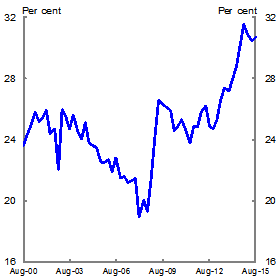
But viewed alongside economies like Canada and Brazil that are also facing downturns in their terms of trade, Australia has done well to avoid recession.
We are also performing better than we have at comparable times in our own economic history.
Following the terms of trade boom in the 1970s, Australia’s unemployment rate tripled as the economy slipped into recession.
Now three years on from the more recent peak in our terms of trade, the economy has continued to expand – albeit at a below-trend pace.
Again, this is especially remarkable given the height of the mining investment ‘cliff’ we are now falling off, and the direct and indirect impact this is having on economic growth.
It is true that the ramp-up in mining exports has contributed strongly to economic growth, and more than offset the direct impact of declining mining investment.
But the indirect effects of falling construction activity in the mining sector should not be understated, with businesses reliant on demand from the mining sector also being affected.
In this context, the flexibility and resilience of the labour market through this period of adjustment has been particularly encouraging.
Wage adjustments have allowed firms to retain workers or even expand their workforces in the face of softer domestic demand, helping to prevent the build-up in long-term unemployment witnessed in previous episodes of below-trend growth.
Here, we are benefiting from past policies that decentralised wage setting.
This is really important, because as we move out of the mining-investment boom and towards broader-based growth, labour and capital need to be able to move to those parts of the economy that can best employ them. Flexibility in wage setting and employment agreements is allowing this to happen more quickly than in the past.
As labour demand and wages growth have moderated in the mining industry, other industries have become relatively more attractive.
For growing parts of the economy such as services and residential construction, this flexibility is facilitating a faster reallocation of labour than we would have expected in the past.
In the chart, the green segments represent employment growth in services, the grey construction, the red manufacturing and the blue mining. The black dots are total employment growth.
We can see that the shift towards more labour-intensive services industries has gathered pace over the past year, far outweighing employment falls in the mining and manufacturing industries.
This followed a period of softer employment outcomes between mid-2012 and mid-2014, as the initial impact of the lower terms of trade and falling mining investment weighed on labour demand across the whole economy.
Chart 5: Annualised employment growth by industry
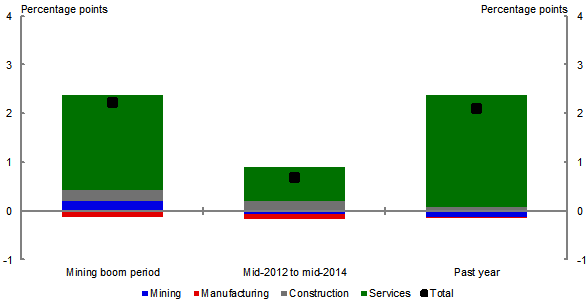
Source: ABS Cat. No. 6291.0.55.003.
Our floating exchange rate is also playing a role in this transition.
The Australian dollar has depreciated 30 per cent against the US dollar since the terms of trade peak. This is improving our export competitiveness and providing a boost to our import-competing industries, including services, at a time when we need the non-mining economy to fill the hole left by falling mining investment.
In particular, the lower exchange rate has encouraged Australians to switch from foreign to domestic tourism as well as encouraging a pick-up in demand from international visitors. Together, this has seen a large turnaround in our ‘tourism trade balance’ over the past two years or so, which is shown as the blue line in the chart. The red line shows the trade weighted index, inverted.
Chart 6: Tourism trade balance and the exchange rate
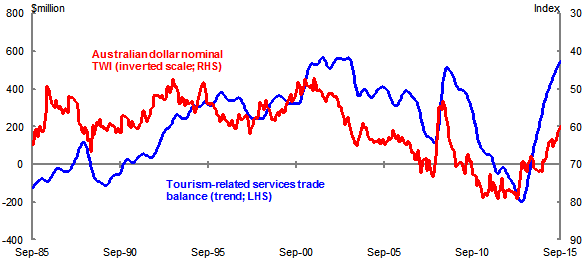
Source: ABS Cat. No. 5368.0 and RBA.
There are other encouraging signs that the transition towards broader-based growth is underway.
Housing investment continues to grow strongly supported by low interest rates, and investment in the services sector is also beginning to pick up, with a solid rise of 5 per cent in 2014-15.
While it is true that the services sector has a relatively low capital intensity, the services sector accounts for about 70 per cent of the Australian economy and historically makes up a much larger share of business investment than the mining industry.
Chart 7: Business investment by industry
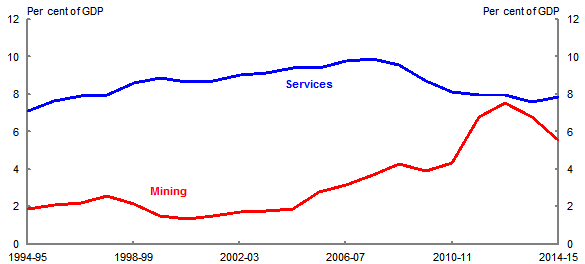
Source: ABS Cat. No. 5204.0
With improving demand conditions and profitability, many of the ingredients are in place for non-mining business investment to strengthen further. For example, the latest National Australia Bank (NAB) business survey shows that non-mining conditions have reached their highest level since mid-2008 and that overall capacity utilisation is now tracking above its long-run average after 4 years of below average outcomes.
Chart 8: NAB non-mining business conditions
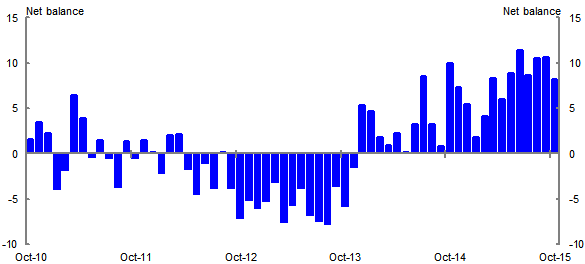
Source: NAB Monthly Business Survey.
Chart 9: NAB capacity utilisation

Source: NAB Monthly Business Survey.
That said, the forecast recovery in non-mining business investment, while modest by historical standards, remains a major risk to the domestic growth outlook.
There are also some notable risks to the outlook on the international side.
The United States’ exit from a near-zero policy interest rate has the potential to destabilise global financial markets, which have to varying extent grown accustomed to the US’s easy monetary policy settings.
Emerging market economies, in particular, have accumulated large amounts of debt in recent years, making them more vulnerable to sudden shifts in market expectations about the trajectory of US monetary policy.
China’s transition away from commodity-intensive growth towards the services sector will continue to have a large, but uncertain, impact on global commodity prices. On the other hand, it will continue to generate new opportunities for exports of services to China.
More broadly, global inflation pressures remain weak. Recent commodity price movements, such as the fall in oil prices over the past year, are suppressing current inflation. But of greater concern is that medium- and longer-term inflation expectations in the major advanced economies have also fallen, suggesting that markets are questioning whether growth will be strong enough to lift inflation sustainably.
But like the vast majority of forecasters, we’re expecting that, with the fundamental drivers of economic activity in place, the Australian economy will strengthen towards trend growth over the next two years.
Medium-term projections
There was criticism of the Budget that the projections for real GDP growth over the medium term were too high.
Some have suggested these projections were raised in order to improve the Budget position. Can I say at th
e outset that this claim is simply not true. In fact, when Treasury introduced the current methodology in the 2014-15 Budget, we published analysis in a separate Working Paper showing that the impact of these changes on the underlying cash balance was very small – an increase of just one-tenth of a per cent of GDP by the end of the medium term.
It is true that Treasury’s framework assumes that the economy will grow faster than potential for a period into the medium term.
This reflects our estimates that the economy is currently operating well inside the limits of its productive capacity, following a period of below-potential growth over recent years. This view is supported by the slow growth in wages and prices that we are currently seeing.
We expect the economy will still be operating with excess capacity by the end of the forecast period in June 2017, even factoring in a modest pick-up in growth over the next two years.
In these circumstances, we assume that necessary adjustments in prices and wages will see the economy’s spare capacity absorbed and the unemployment rate decline towards the NAIRU over a number of years. Similar approaches are used by the Congressional Budget Office in the United States and the UK’s Office for Budget Responsibility.
Our previous approach was to assume that the unemployment rate returned to the NAIRU in the first year of the projection period. This assumption had the considerable benefit of simplicity. And so it had merit when the unemployment rate was not far from the NAIRU. But it was (rightly) criticised as being an unrealistic assumption in circumstances where the unemployment rate was expected to be significantly above the NAIRU by the end of the forecast period.
And in such circumstances, the methodology suffered from internal inconsistencies. While the unemployment gap was assumed to close, the output gap was implicitly retained.
Another alternative is to assume that an output gap will exist indefinitely, and that the unemployment rate will remain above the NAIRU. Apart from also being unrealistic, the assumption that cyclical unemployment will last indefinitely would seem odd given that policy settings are designed to avoid this very thing.
Instead, our approach is to assume that the economy’s output gap will be absorbed over a period. History suggests this takes about five years. For simplicity, we assume that the adjustment takes place evenly over these five years.
By definition, the closing of the output gap requires real GDP to grow faster than potential over this time.
While involving some necessary simplifications, this approach is consistent with historical experience where the economy has tended to grow above potential for a number of years in a row following a period of sustained weakness.
Chart 10: Real GDP growth
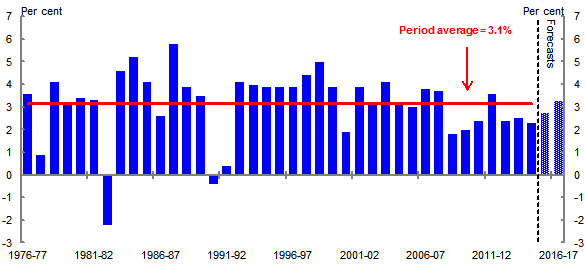
Source: ABS Cat. No. 5204.0 and 2015-16 Budget forecasts.
To implement the methodology we need estimates of the level of potential GDP now and into the future. Potential GDP is not a quantity that we - or anyone else - can directly observe, either now or over history. Instead, we have to use the best methods at hand and the best available data to estimate it. To do this, we estimate trends and make assumptions about each of the economy’s supply side drivers - population, participation and productivity.
Once we have estimated the current level of potential GDP, the next step is to project how potential GDP will evolve over time – that is, we estimate the future growth rate of potential. Again, we do this for each of the 3Ps separately.
Population projections are based on the latest population figures from the ABS and net overseas migration estimates from the Department of Immigration and Border Protection, together with our estimates of fertility and mortality. Projections of the trend participation rate and average hours are built up from age and gender-specific labour force data.
For labour productivity, we assume trend growth of 1.6 per cent, which is the 30-year historical average and is consistent with our approach in the Intergenerational Report.
But none of these numbers is set in stone.
And like similar national economic advisers overseas, Treasury continually reassesses its estimates of potential growth and the size of the output gap in light of new data and new methods.
New evidence on the size of the population suggests that Australia’s current productive capacity is slightly lower than we estimated at the time of the Budget in May.
Australia has experienced rapid population growth over the past ten years, fuelled by solid increases in net overseas migration. This came on the back of our relatively strong economic performance and low unemployment compared to other countries. But as economic growth has softened, recent immigration outcomes have come in lower than the Department of Immigration and Border Protection initially expected. This mainly reflected declines in temporary visa holders and lower net migration from New Zealand.
Chart 11: Revisions to growth in working-age population
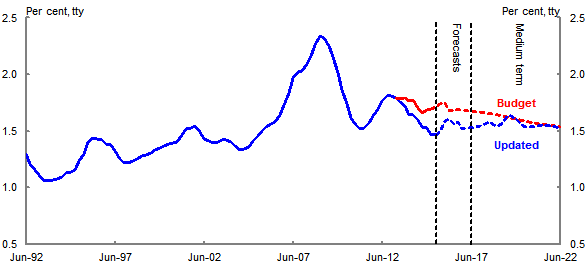
Source: ABS Cat. No. 6202.0 and Treasury.
The revised data from the ABS – shown in the blue line in the chart – showed that growth in the working-age population slowed to 1½ per cent over the year to June 2015, well below the Budget assumption of 1¾ per cent and for that matter well below its average yearly growth over the past ten years (also 1¾ per cent). Like the Reserve Bank, we expect Australia’s population to continue to increase at around its current, slower rate of growth over the next few years.
This has immediate and unavoidable consequences for the economy’s potential: fewer people means a smaller supply of employees. So for a given capital stock and level of productivity, we can now produce less output overall than we previously estimated.
We have also reconsidered the contribution of average hours worked to potential GDP going forward In light of new data. The latest quarterly data suggest that a larger portion of the decline in average hours reflects trend rather than cyclical factors, implying that the previous recovery in average hours factored into our projections may be too large. Our revised estimates of trend are shown in the solid red line in the chart.
Chart 12: Average hours worked – trend and cycle
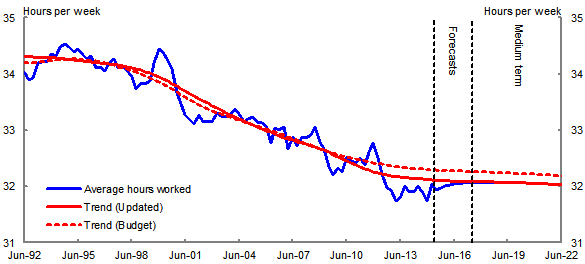
Source: ABS Cat. No. 6202.0 and Treasury.
Taken together, the latest data on the population and labour force trends suggest that potential output will be lower than estimated at Budget. We now think potential GDP will grow by around 2¾ per cent over the next few years, lower than the 3 per cent estimated at Budget.
It’s also worth noting that the ageing of the population means that the economy’s potential growth rate is projected to fall slowly over time, reaching 2½ per cent by 2050.
As a consequence of these changes, the output gap will be smaller than estimated at Budget. The chart shows our latest estimates of the history of the output gap, compared with Budget.
Chart 13: Output gap estimates
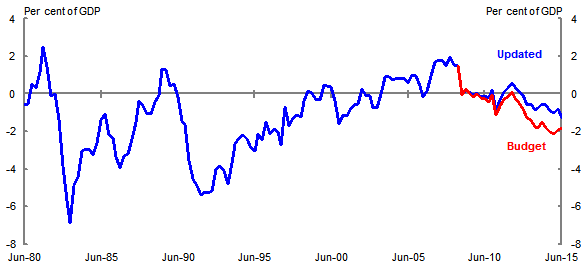
Source: ABS Cat. No. 5206.0 and Treasury.
We will finalise our forecasts for MYEFO after the national accounts are released next week and in ligh
t of our latest business liaison round, which we completed last week. Those forecasts will inform our estimate of the output gap at the end of 2016-17 and so the pace at which the economy will need to grow to close it over the following five years.
But it is likely that, on average, we won’t have to grow quite so fast to get there as we previously thought. The economy will of course, by definition, still have to grow a bit faster than potential.
It needs to be remembered that Treasury forecasts the economy predominantly to inform the budget. While our analysis of the economy also informs policy development more broadly, it is the need to prepare estimates of revenue and expenditure over the forward estimates and beyond that drives our approach.
And it is nominal GDP that matters for revenue.
When unemployment is above the NAIRU, it is reasonable to expect that wages and prices will grow more slowly than usual. That effect was one of the main reasons why the change in methodology in 2014 had a smaller fiscal impact than many commentators expected.
The slower price growth drags directly on the dollar-value of the economy’s output, muting the effect on revenues of strong growth in output volumes.
And whereas the economy fully recovers lost ground on output volumes over the assumed period of cyclical adjustment, this is not the case for nominal GDP. The dollar value of the economy’s output that is lost to slow price growth over the medium term is lost forever.
Changes in population, prices and the number of people unemployed will all affect estimates of expenses. The Government will publish revised estimates of the projected medium-term fiscal position in MYEFO. Compared with the Budget base, it is reasonable to conclude that the changes to population and hours worked that I have outlined would, everything else equal, lower the path of the projected underlying cash balance.
It is important to reiterate that this all rests on our economic projections, which are based on a set of assumptions about how the economy works:
- assumptions about the supply-side drivers of Australia’s productive capacity – about population, participation and productivity; and
- assumptions about the time it takes to return the economy to potential output through adjustments in prices and quantities in the labour market.
There are a number of reasons why our projections could be wrong.
The output gap might be smaller than our estimates. Our revised projections reflect the recent downgrades to historical population data. But if trend participation is lower than our estimates, this might mean potential output, and the output gap, is smaller than the projections assume. As a result, the economy might not need to grow as fast to return to potential. Present conditions in the labour market – the wage price index is growing at its slowest pace on record - and measures of underutilisation suggest there is a large amount of spare capacity in the economy. To us, this signals that there is currently a large output gap even when we factor in lower population growth.
The NAIRU might be higher than our estimated 5 per cent. This would also narrow the output gap as it would erode Australia’s available labour resources. Our experience during the mid-2000s provides some reassurance that the NAIRU is about 5 per cent and that we can operate with an unemployment rate around this level without inflation rising too much.
On the other hand, long periods of high unemployment, and in particular, widespread long-term unemployment, could cause a structural lift in the non-accelerating inflation rate of unemployment. You might expect this outcome in periods of excessively high unemployment where the long-term unemployed lose skills and their connection with the labour market. However we are not now in a recession. And Australia’s current long-term unemployment rate is nowhere near what it was in past recessions.
Productivity growth could be slower than it has been in the past. Our projections assume labour productivity will grow in line with its average rate of growth over the past 30 years. Productivity could grow more slowly because of structural shifts in the economy. As services become a bigger part of our economy, productivity growth could ease. Equally, breakthrough innovation and the realisation of productivity gains from current technologies could see productivity grow faster than it has in the past.
This heavy reliance on this set of assumptions highlights the need for Treasury to continue to expose our frameworks and assumptions to outside scrutiny.
We regularly check our methods against the best approaches used by forecasters both domestically and overseas. And our methodologies are published in working papers that are freely available online – this includes our methodology for the medium-term projections. We are releasing today a short note that sets out in more detail our updated estimates of potential growth and the output gap.
Conclusion
Returning briefly to where I started. The transition underway in the domestic economy is unfolding broadly as we expected at Budget, with the labour market performing, if anything, a bit better. In the interim, the outlook for the global economy has deteriorated somewhat and, perhaps more importantly, global risks are now more elevated.
New data, particularly on population and hours worked, has led us to revise down our estimate of both the level and the near-term growth rate of potential.